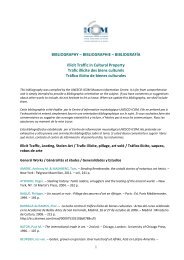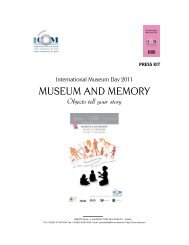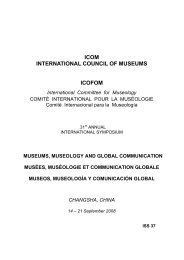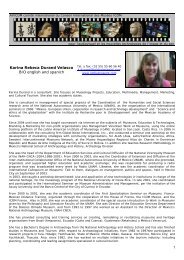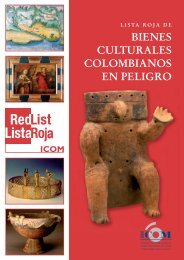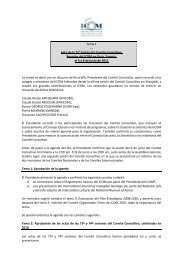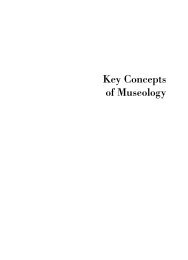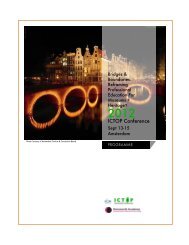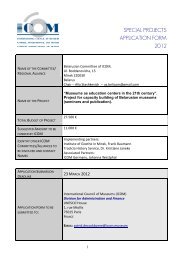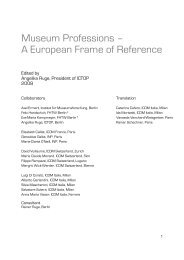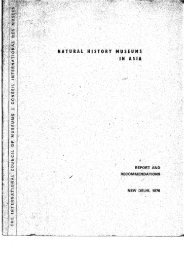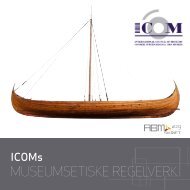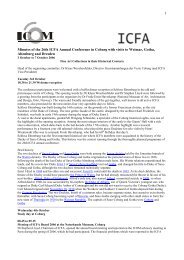ISS 25 (1995).pdf - The International Council of Museums
ISS 25 (1995).pdf - The International Council of Museums
ISS 25 (1995).pdf - The International Council of Museums
Create successful ePaper yourself
Turn your PDF publications into a flip-book with our unique Google optimized e-Paper software.
the museum. <strong>The</strong>y were curious, and some <strong>of</strong> them also collected things for<br />
us. <strong>The</strong>y got an owner's attitude to the museum.<br />
When we opened the museum, there were about 1000 visitors in the<br />
workmen's dwelling in one week. At that time we had already produced a<br />
slides show called "<strong>The</strong> children at Bakke", which told about the living<br />
conditions in the neighbourhood around the workmen's dwellings. It became<br />
very popular, and today slide shows are our speciality.<br />
Since little or nothing had been done to collect the history <strong>of</strong> industrial Odda<br />
until this museum project was established, we had to form different groups to<br />
work with various subjects. One group started to collect working equipment at<br />
the Norzink factory in order to display the work in a big factory.<br />
Unfortunately much was already thrown away. We therefore had to involve<br />
the specialists in their own history, and my task was to advice, co-ordinate and<br />
encourage the museum work. For example we succeeded in documenting by<br />
photos and tape recordings the last working day at the old production hall at<br />
Norzink.<br />
Little by little the museum became a reality and a positive factor in people's<br />
mind, and thus their identity was strengthened. This was not the case when the<br />
work with the museum started. <strong>The</strong>n people from Odda <strong>of</strong>ten felt<br />
discriminated and thought that their history was <strong>of</strong> little value because the<br />
factories here were polluters. It was merely a shame to tell for example people<br />
in the capital <strong>of</strong> Oslo that you came from Odda, a terrible place with heavy<br />
industry and politically radical people .<br />
. After three years <strong>of</strong> work paid by the local authorities, the trade unions, the<br />
power company and the factories, the Western Norway Industrial Museum was<br />
established with three persons fully employed, a curator and leader, an<br />
archivist and a secretary, all women. As from now the museum also got a<br />
yearly grant from the state.<br />
<strong>The</strong> museum experienced a great deal <strong>of</strong> goodwill from the local society and<br />
received project money from the state for pioneer work in the field <strong>of</strong><br />
documentation <strong>of</strong> industrial history. We also catalogued and saved the<br />
voluminous archives at the three factories and the hydro power station for the<br />
purpose <strong>of</strong> research and preservation. Gradually we also succeeded in<br />
restoring three workmen's dwellings and started on the next neglected field,<br />
architecture and the history <strong>of</strong> technology.<br />
We engaged the museum in the issue <strong>of</strong> pollution. This was a touchy topic for<br />
many persons in the local society. To put it simply, it was not good public<br />
relation policy. In addition the pollution problems did not catch much interest<br />
among ordinary people at that time. Today, with many <strong>of</strong> the pollution<br />
problems being solved, the museum is asked to show all sides <strong>of</strong> the industry,<br />
198



